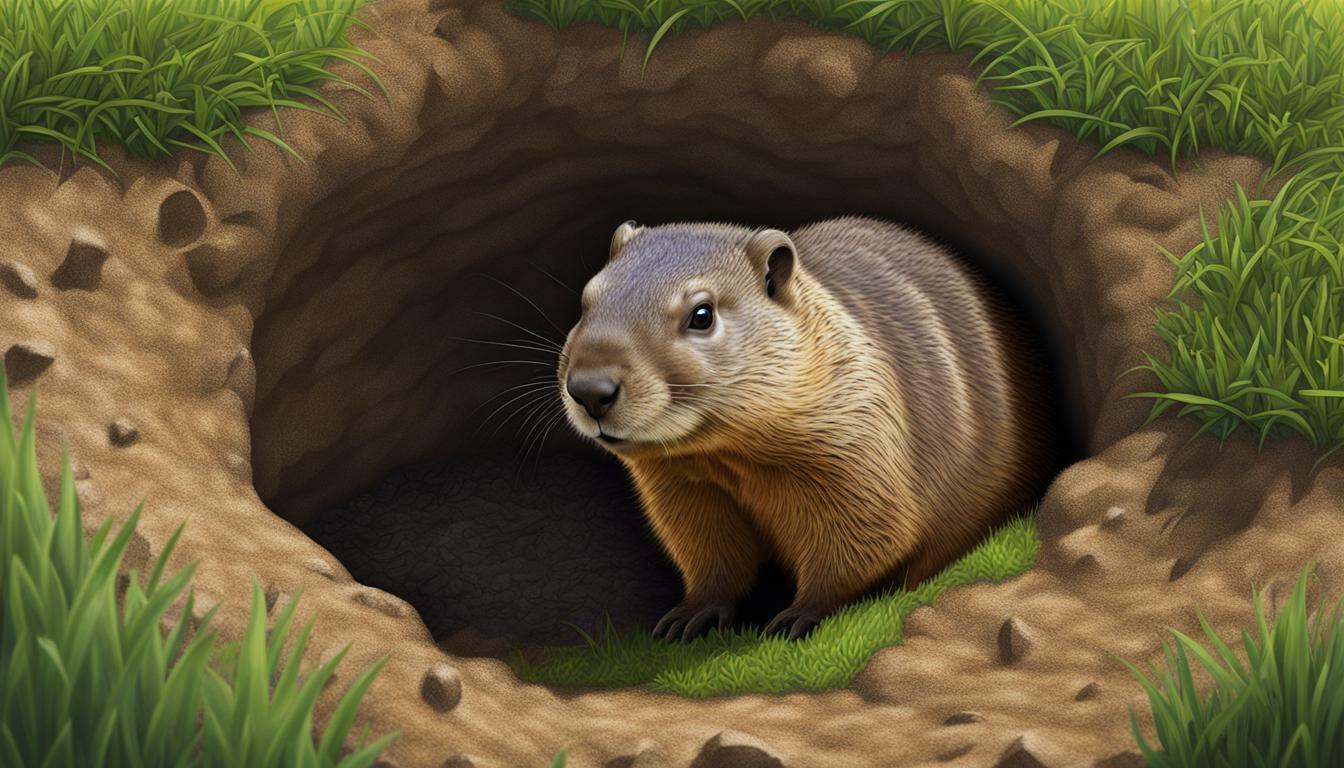Groundhogs have a relatively short pregnancy period, typically lasting between 30 and 33 days after mating. During this time, the female groundhog will create a nest in an underground burrow and give birth to a litter of one to nine infants. The mother groundhog is the sole caregiver of the pups, and they rely on her for survival for the first month of their lives. After 44 days, the young groundhogs are weaned and become independent. Male and female groundhogs reach sexual maturity between one and two years of age.
Key Takeaways:
- Groundhogs have a pregnancy period that lasts approximately 30 to 33 days after mating.
- Female groundhogs create underground burrow nests for giving birth to their offspring.
- Pups rely on their mother for care and survival in their first month of life.
- Young groundhogs become independent after approximately 44 days.
- Male and female groundhogs reach sexual maturity between one and two years of age.
Understanding Groundhog Gestation Period
The gestation period of groundhogs, also known as the length of their pregnancy, spans approximately 30 to 33 days. This means that from the time a female groundhog mates with a male, it takes about a month for her to give birth to a litter of adorable groundhog pups. It’s a relatively short pregnancy compared to some other animals!
During this time, the female groundhog will prepare a nest in an underground burrow to give birth to her offspring. These burrows provide a safe and cozy environment for the mother and her babies. Once the pups are born, they rely solely on their mother for care and nourishment. She takes on the role of caregiver, ensuring their survival during their first month of life.
After about 44 days, the young groundhogs are weaned and become independent. They start exploring the world outside of the burrow and gradually learn to fend for themselves. It’s incredible how quickly these little creatures grow and develop!
| Key Points: | – Groundhog gestation period is 30 to 33 days. | – Female groundhogs prepare nests in underground burrows for giving birth. | – Mother groundhogs are the sole caregivers of their pups during the first month of their lives. | – Young groundhogs become independent after around 44 days. |
|---|
Nest Preparation and Birth
During their pregnancy, female groundhogs create nests in underground burrows, where they eventually give birth to a litter of one to nine infants. These nests, also known as dens, provide a safe and protected environment for the newborn groundhogs. The mother groundhog carefully constructs the nest using leaves, grass, and other soft materials, creating a cozy space for her offspring.
Once the nest is prepared, the female groundhog gives birth to her pups, which are also known as kits or infants. The number of infants in a litter can vary, ranging from one to nine. The newborn groundhogs are blind, hairless, and completely dependent on their mother for nourishment and care.
During the first month of their lives, the mother groundhog plays a vital role as the sole caregiver of the pups. She provides them with milk, keeps them warm, and protects them from predators. As the infants grow, their fur starts to develop, and they become more active. After approximately 44 days, the young groundhogs are weaned and begin to eat solid foods. At this point, they become more independent and start exploring their surroundings.
| Key Facts: | Groundhog Nest | Groundhog Infants |
|---|---|---|
| Number of Infants: | Varies from one to nine | – |
| Caregiver: | Mother groundhog | – |
| Weaning Age: | Approximately 44 days | – |
| Independence: | Young groundhogs become more independent after weaning | – |
Caregiving Responsibilities
The mother groundhog plays a crucial role as the sole caregiver of her pups, as they rely on her for their survival during the first month of their lives. Groundhog pups are born blind, hairless, and completely dependent on their mother for warmth, nourishment, and protection. Within a few hours after birth, the mother groundhog will start producing milk to feed her offspring.
The mother groundhog creates a nest inside her underground burrow, lining it with soft materials like grass and leaves to provide a comfortable and safe environment for her pups. She will nurse and groom them, ensuring their cleanliness and well-being. It is fascinating to observe how the mother groundhog interacts with her pups, gently nudging them and keeping them close by.
As the pups grow, the mother groundhog gradually introduces them to solid food. She brings back fresh vegetation from outside the burrow, teaching her young ones to forage and develop their taste for a variety of plants. This process helps the pups gain the necessary skills to become independent as they grow older.
Table 1: Groundhog Caregiving Responsibilities
| Responsibility | Description |
|---|---|
| Nursing | The mother groundhog provides milk for her pups to ensure their growth and development. |
| Grooming | The mother groundhog keeps her pups clean and free from parasites by grooming them regularly. |
| Nest Building | The mother groundhog constructs a nest within her burrow to provide a warm and safe environment for her pups. |
| Teaching | The mother groundhog teaches her pups to forage for food and gain the necessary skills for independent survival. |
Throughout this caregiving period, the mother groundhog exhibits incredible maternal instincts and dedication. She ensures that her pups are well-nourished, protected, and ready to face the challenges of the outside world when the time comes.
Weaning and Independence
After approximately 44 days, young groundhogs are weaned and gain independence from their mother. During this critical period, the mother groundhog gradually reduces her nursing and starts introducing solid foods to her growing pups. It is an essential step in their development as they transition from relying solely on their mother’s milk to foraging and feeding themselves.
As the young groundhogs become more independent, they will start venturing outside the nest and exploring their surroundings. They learn essential skills such as foraging for food, digging burrows, and identifying potential threats. Their mother will continue to watch over them and provide guidance, but the young groundhogs will increasingly rely on their own instincts and abilities.
During this time, the young groundhogs develop their unique personalities and characteristics. Some may be more adventurous and curious, while others may be more cautious and reserved. Each individual groundhog will find its place in the world as it grows and learns from its environment.
| Five Key Points About Weaning and Independence in Young Groundhogs |
|---|
| 1. Weaning occurs after approximately 44 days of birth. |
| 2. The mother gradually reduces nursing and introduces solid foods to the young groundhogs. |
| 3. Young groundhogs start exploring their surroundings and learning essential skills for survival. |
| 4. The mother continues to provide guidance, but the young groundhogs become increasingly independent. |
| 5. Each young groundhog develops its own unique personality and characteristics. |
The weaning and independence period is a significant milestone in the lives of young groundhogs. It marks the beginning of their journey towards adulthood and self-reliance. As they grow and mature, they will face new challenges and experiences, shaping them into capable members of the groundhog community.
Groundhog Sexual Maturity
Both male and female groundhogs typically reach sexual maturity between one and two years of age. This is the stage in their life cycle when they become capable of reproducing and continue the cycle of groundhog population. Understanding the development of sexual maturity in groundhogs is crucial for studying their reproductive behavior.
During their first year, groundhogs focus on growing and establishing their burrows. It is not until the second year that they begin to show signs of sexual maturity. For males, this is marked by an increase in their territorial behaviors and the development of their secondary sexual characteristics, such as enlarged testicles. Females, on the other hand, start attracting potential mates through scent marking and vocalizations.
Once they reach sexual maturity, male groundhogs will actively search for females to mate with. Females, however, are selective in their choice of mates and will only breed with the most dominant male in their territory. This ensures that their offspring have the best chance of survival in the competitive world of groundhog burrows.
| Key Points: | Groundhog Sexual Maturity |
|---|---|
| Age: | Between one and two years |
| Changes: | Development of secondary sexual characteristics |
| Behaviors: | Territoriality, scent marking, vocalizations |
| Mating: | Males actively seek females, while females are selective |
Interesting Facts about Groundhog Reproduction
Groundhog reproduction includes fascinating aspects, such as their short pregnancy period and the litter sizes they produce. These facts shed light on the unique characteristics of these furry creatures.
Did you know that groundhogs have a relatively short pregnancy period? After mating, female groundhogs carry their young for only 30 to 33 days, which is remarkably brief compared to other animals. This fast-paced gestation period showcases the efficiency of groundhog reproduction.
Another intriguing aspect of groundhog reproduction is the range of litter sizes they produce. Female groundhogs can give birth to a litter of one to nine infants, although four or five is the average. This variability in litter size allows groundhog populations to adapt and thrive in different environments.
Groundhog Reproduction at a Glance:
| Pregnancy Period | Litter Sizes |
|---|---|
| 30-33 days | 1-9 infants |
Groundhog reproduction showcases the incredible abilities of these animals to adapt and multiply. Their short pregnancy period and diverse litter sizes contribute to the sustainability and survival of their species in the wild.
Groundhog Reproduction Cycle: A Closer Look
Groundhogs follow a reproductive cycle that encompasses mating, pregnancy, birth, and raising their young. Understanding this cycle can provide valuable insights into the fascinating world of groundhog reproduction.
After mating, female groundhogs undergo a relatively short pregnancy period of 30 to 33 days. During this time, they diligently prepare a nest within their underground burrows. These cozy nests provide a safe and secure environment for the impending birth.
Once the gestation period is complete, the female groundhog gives birth to a litter of one to nine infants, known as pups. The mother groundhog assumes sole caregiving responsibilities for the vulnerable pups, who depend on her for their survival during the first month of their lives.
After approximately 44 days, the young groundhogs are weaned and begin their journey towards independence. They gradually learn to forage for food and navigate their surroundings without the constant assistance of their mother. Male and female groundhogs reach sexual maturity between one and two years of age, completing the reproductive cycle.
| Reproductive Stage | Duration |
|---|---|
| Mating | Varies |
| Pregnancy | 30-33 days |
| Birth | Varies (1-9 pups) |
| Weaning | Approximately 44 days |
| Sexual Maturity | 1-2 years |
As you can see, the groundhog reproductive cycle is both efficient and intricate, ensuring the perpetuation of their species. So the next time you spot a groundhog in your backyard, take a moment to appreciate the remarkable journey they undertake in bringing new life into the world.
Groundhog Pregnancy Duration: Variations and Factors
While the average groundhog pregnancy lasts 30 to 33 days, there can be variations influenced by factors such as nutrition, climate, and genetics. These factors can affect the length of gestation and contribute to differences in pregnancy durations among individual groundhogs. It is important to note that these variations are natural and occur within the normal range of groundhog reproductive cycles.
Nutrition plays a crucial role in the development of the embryos and the overall health of the pregnant groundhog. A well-nourished mother groundhog may have a shorter pregnancy duration compared to one with inadequate nutrition. Similarly, climate conditions can impact the availability of food and resources, which can in turn affect the groundhog’s reproductive cycle and pregnancy duration.
Genetics also play a significant role in the length of groundhog pregnancy. Different groundhog populations may have genetic variations that can influence the duration of pregnancy. Some individuals may have shorter or longer gestation periods based on their genetic makeup.
Overall, variations in groundhog pregnancy duration are normal and natural. These variations ensure the adaptability and survival of the species in different environments. By understanding the factors that can influence pregnancy duration, we can gain valuable insights into the reproductive biology of groundhogs and their ability to adapt to changing conditions.
| Factors Affecting Groundhog Pregnancy Duration |
|---|
| Nutrition |
| Climate |
| Genetics |
Groundhog Pregnancy vs. Other Animals
Groundhogs have a relatively short pregnancy period compared to many other mammalian species. After mating, the female groundhog’s gestation period lasts approximately 30 to 33 days. This is significantly shorter than the pregnancy durations of larger mammals like elephants and whales, which can range from 18 to 22 months. Even compared to other rodents, such as mice and rats, groundhog pregnancies are relatively brief.
During their pregnancy, female groundhogs create a nest in their underground burrows, providing a safe and secure environment for their upcoming litter. Once the gestation period is complete, the mother groundhog will give birth to a litter of one to nine infants, also known as pups. Interestingly, groundhogs are one of the few mammalian species that can give birth to such a large number of offspring in a single litter.
Unlike many other animal species, where both parents may contribute to the care of the young, it is the mother groundhog who takes on the sole responsibility of caregiving. For the first month of their lives, the infant groundhogs rely entirely on their mother for survival. She nurtures them, provides milk, and guides them in their early stages of development.
| Groundhog | Elephant | Whale | Mouse | Rat |
|---|---|---|---|---|
| 30-33 days | 18-22 months | 18-22 months | 19-21 days | 21-23 days |
Summary
- Groundhogs have a relatively short pregnancy period of 30 to 33 days.
- Compared to larger mammals like elephants and whales, groundhog pregnancies are significantly shorter.
- In a single litter, a female groundhog can give birth to one to nine pups.
- The mother groundhog is the sole caregiver and provides all the necessary care and nourishment for the first month of the pups’ lives.
Groundhog Reproduction FAQs
Here are some commonly asked questions and answers regarding groundhog reproduction and pregnancy:
1. How long is the gestation period for groundhogs?
The gestation period for groundhogs is relatively short, lasting between 30 to 33 days after mating. During this time, the female groundhog prepares a nest in an underground burrow and gives birth to a litter of one to nine infants.
2. Do male groundhogs play a role in caregiving?
No, male groundhogs do not contribute to caregiving. The mother groundhog is the sole caregiver for her pups, providing them with nourishment and protection during their first month of life.
3. At what age do groundhogs become independent?
Groundhog pups become independent after approximately 44 days. Once they are weaned, they start venturing out on their own, exploring their surroundings and learning to find food and build their own burrows.
4. When do male and female groundhogs reach sexual maturity?
Male and female groundhogs reach sexual maturity between one and two years of age. At this stage, they are capable of reproducing and continuing the groundhog life cycle.
| Question | Answer |
|---|---|
| How long is the gestation period for groundhogs? | The gestation period for groundhogs is between 30 to 33 days. |
| Do male groundhogs play a role in caregiving? | No, male groundhogs do not participate in caregiving. |
| At what age do groundhogs become independent? | Groundhog pups become independent after approximately 44 days. |
| When do male and female groundhogs reach sexual maturity? | Male and female groundhogs reach sexual maturity between one and two years of age. |
Groundhog reproduction and pregnancy present fascinating aspects of their life cycle. By understanding the gestation period, caregiving responsibilities, independence, and sexual maturity, we gain insights into these incredible creatures.
Conclusion
Groundhogs have a relatively short pregnancy period of approximately 30 to 33 days, during which the female groundhog creates a nest and gives birth to a litter of one to nine infants. The mother groundhog is the sole caregiver of the pups for the first month of their lives, providing them with warmth, nourishment, and protection. It is during this critical period that the young groundhogs rely on their mother for survival.
After around 44 days, the young groundhogs begin the process of weaning and gradually become independent. During this time, they will start exploring their surroundings outside of the nest and learn essential skills for survival. The mother groundhog guides them through this transition, gradually reducing her care until the young groundhogs are fully capable of fending for themselves.
Male and female groundhogs reach sexual maturity between one and two years of age. At this stage, they are ready to reproduce and continue the groundhog life cycle. The length of their pregnancy and the care they provide to their young ensure the survival and growth of the groundhog population.
In summary, groundhogs have a short but crucial pregnancy period, during which the female groundhog prepares a nest and gives birth to a litter of one to nine infants. The mother groundhog undertakes the responsibility of caring for the vulnerable pups, who become independent after approximately 44 days. Male and female groundhogs reach sexual maturity between one and two years of age, continuing the cycle of life for these fascinating animals.
FAQ
How long is the gestation period for groundhogs?
Groundhogs have a short pregnancy period of 30 to 33 days.
Where do female groundhogs give birth?
Female groundhogs create a nest in an underground burrow to give birth.
How many infants do groundhogs usually have in a litter?
Groundhogs typically have a litter of one to nine infants.
Who takes care of the groundhog pups after birth?
The mother groundhog is the sole caregiver of the pups.
How long do groundhog pups rely on their mother for survival?
Groundhog pups rely on their mother for survival for the first month of their lives.
At what age do male and female groundhogs reach sexual maturity?
Male and female groundhogs reach sexual maturity between one and two years of age.
Any interesting facts about groundhog reproduction?
Groundhogs have a unique reproductive cycle and exhibit interesting behaviors during pregnancy.
Can you explain the weaning process for groundhog pups?
Groundhog pups are weaned after 44 days and become independent.
What are the factors that can affect groundhog pregnancy duration?
Groundhog pregnancy duration can be influenced by various factors such as environmental conditions and availability of resources.
How does groundhog pregnancy duration compare to other animals?
Groundhog pregnancy duration is relatively short compared to many other animals.
What are some common questions about groundhog reproduction?
Here are some frequently asked questions about groundhog reproduction and pregnancy.




